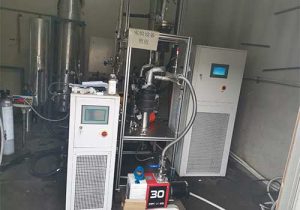ultra low temperature recirculating chillers
Ultra low temperature recirculating chillers are highly sophisticated pieces of equipment engineered to provide precise cooling at extremely low temperatures, often well below the freezing point of water. These chillers play a crucial role in a wide range of industries and scientific research applications where maintaining a consistent, low temperature environment is of utmost importance.

The components of an ultra low temperature recirculating chiller are carefully designed to function in harsh, low temperature conditions. The compressor is a fundamental part, responsible for compressing the refrigerant gas. In ultra low temperature models, the compressors are often specialized to handle the unique requirements of low temperature refrigeration, such as higher pressure ratios and more efficient heat transfer. The condenser works to release the heat absorbed by the refrigerant during the cooling process. This is typically achieved through air or liquid cooling methods, depending on the design of the chiller.
The evaporator is where the actual cooling of the fluid takes place. In ultra low temperature chillers, the evaporator is designed to efficiently transfer heat from the process fluid (usually a coolant or a specific liquid used in the application) to the refrigerant. Advanced control systems are also a key component, allowing for precise temperature regulation. These systems can monitor and adjust various parameters such as refrigerant flow, compressor speed, and cooling capacity to maintain the desired ultra low temperature.

In the field of scientific research, ultra low temperature recirculating chillers are extensively used in cryogenic experiments. For example, in materials science, researchers may use these chillers to study the properties of materials at extremely low temperatures. This can help in understanding how materials behave under cryogenic conditions, which is valuable for developing new materials with unique properties for applications like superconductors. In biology and biochemistry, ultra low temperature chillers are used to preserve biological samples such as cells, tissues, and enzymes. By maintaining these samples at ultra low temperatures, their viability and integrity can be preserved for long periods, enabling further research and analysis.
The pharmaceutical industry also relies on ultra low temperature recirculating chillers. They are used to store and transport sensitive drugs, vaccines, and biological products that require extremely low temperatures to maintain their efficacy. These chillers ensure that the products remain within the specified temperature range, preventing degradation and ensuring their safety and effectiveness.
In high-tech manufacturing processes, such as semiconductor manufacturing, ultra low temperature chillers are used to cool critical components during production. Precise temperature control is essential in semiconductor manufacturing to ensure the quality and performance of the chips. The ultra low temperatures help in preventing thermal expansion and contraction issues that could lead to defects in the manufacturing process.

The working principle of ultra low temperature recirculating chillers is based on a complex refrigeration cycle. The refrigerant undergoes a series of phase changes, starting from a low-pressure gas in the evaporator, where it absorbs heat from the process fluid. It then moves to the compressor, where its pressure and temperature increase. The high-pressure, high-temperature refrigerant then enters the condenser, where it releases heat and condenses back into a liquid. Finally, the liquid refrigerant passes through an expansion device, reducing its pressure and temperature, and returns to the evaporator to repeat the cycle.
Maintenance of ultra low temperature recirculating chillers is crucial for their reliable operation. Regularly monitoring the refrigerant levels is essential, as any loss of refrigerant can significantly affect the cooling performance. Checking for leaks in the refrigerant system is also important, as even small leaks can lead to a decrease in efficiency and potential damage to the chiller. Keeping the components clean, especially the condenser and evaporator coils, helps in maintaining optimal heat transfer. Additionally, periodic servicing of the compressor and other mechanical components can prevent wear and tear and extend the lifespan of the chiller.
In conclusion, ultra low temperature recirculating chillers are indispensable in many scientific, industrial, and medical applications. Their ability to provide precise and consistent ultra low temperature cooling makes them a vital tool for various processes. By understanding their components, applications, working principle, and maintenance requirements, users can ensure the efficient and reliable operation of these complex cooling systems.
Related recommendations
split chiller
403Split Chillers: Definition, Types, Efficiency, Market Trends, and Technical Specifications Definition of Split Chillers A split chiller is a versatile air conditioning system designed to pro...
View detailsindustrial process chillers
386Industrial Process Chillers: Vital for Precise Temperature Control Industrial process chillers play a critical role in a wide range of industries where temperature control is essential for proc...
View detailsApplication Industries and Fields of Chillers
1201Application Industries and Fields of Chillers Cold water machine can be used for vacuum equipment. Such cold water machines also meet the needs of high -quality vacuum equipment, such as mol...
View detailssmall thermal chamber
473Small Thermal Chamber: A Comprehensive Guide Introduction A small thermal chamber is an essential tool in various industries and scientific fields, designed to create a controlled environmen...
View details
 LNEYA Chiller
LNEYA Chiller






HelloPlease log in